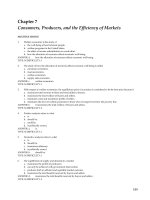Lecture Macroeconomics - Chapter 11: Deficits, surpluses, and the public debt
Bạn đang xem bản rút gọn của tài liệu. Xem và tải ngay bản đầy đủ của tài liệu tại đây (213.23 KB, 31 trang )
Chapter 11
Deficits,
Surpluses,
& the
Public
Debt
Public Mastercard
PUBLIC VISA
Public Mastercard
PUBLIC VISA
SLIDES PREPARED BY JUDITH SKUCE, GEORGIAN COLLEGE
© 2002 McGraw-Hill Ryerson Ltd.
Macroeconomics, Chapter 11
1
In this chapter you will learn
What a budget deficit and a budget surplus
are, and their connection to the public debt
About the recent history of Canada’s budget
surpluses, deficits and public debt
The misconceptions about budget deficits and
the national debt
The substantive issues about budget deficits
and the public debt
The effect of the recent budgetary surplus
© 2002 McGraw-Hill Ryerson Ltd.
Macroeconomics, Chapter 11
2
Chapter 11 Topics
Deficits & Debt: Definitions
Budget Philosophies
The Public Debt: Facts & Figures
False Concerns
Substantive Issues
Deficits & Surpluses: 1990 to the
Present
Options for the Surpluses
© 2002 McGraw-Hill Ryerson Ltd.
Macroeconomics, Chapter 11
3
Deficit & Debt: Definitions
Budget Deficit
Annual amount by which government
expenditures exceed taxes
E.g. 1996/97 deficit = $13.5 billion
Public Debt
Accumulation of all past deficits
E.g. 2000 public debt =$650 billion
© 2002 McGraw-Hill Ryerson Ltd.
Macroeconomics, Chapter 11
4
Chapter 11 Topics
Deficits & Debt: Definitions
Budget Philosophies
The Public Debt: Facts & Figures
False Concerns
Substantive Issues
Deficits & Surpluses: 1990 to the
Present
Options for the Surpluses
© 2002 McGraw-Hill Ryerson Ltd.
Macroeconomics, Chapter 11
5
Budget Philosophies
Annually Balanced Budget
– G = T every year
– Intensifies the cycle (pro-cyclical)
– Politically responsible?
© 2002 McGraw-Hill Ryerson Ltd.
Macroeconomics, Chapter 11
6
Budget Philosophies
Annually Balanced Budget
Cyclically Balanced Budget
– G = T over each business cycle
– Deficits in recessionary downswings
– Surpluses in inflationary upswings
– Counter-cyclical (stabilizes the cycle)
– Not workable in practice
© 2002 McGraw-Hill Ryerson Ltd.
Macroeconomics, Chapter 11
7
Budget Philosophies
Annually Balanced Budget
Cyclically Balanced Budget
Functional Finance
– Balancing the budget is of secondary
importance
– Primary focus is on stabilizing economy
(counter-cyclical policies)
– May result in a large public debt
© 2002 McGraw-Hill Ryerson Ltd.
Macroeconomics, Chapter 11
8
Chapter 11 Topics
Deficits & Debt: Definitions
Budget Philosophies
The Public Debt: Facts & Figures
False Concerns
Substantive Issues
Deficits & Surpluses: 1990 to the
Present
Options for the Surpluses
© 2002 McGraw-Hill Ryerson Ltd.
Macroeconomics, Chapter 11
9
The Public Debt: Facts & Figures
Government of Canada Public Debt, selected years
gross federal public debt (billions)
700
160
600
140
120
500
100
400
80
300
60
200
% of GDP
$ billions
% of GDP
40
100
20
2000
1997
1994
1991
1988
1983
1979
1975
1973
1969
1966
1960
1954
1946
1940
1929
0
1926
0
end of year
© 2002 McGraw-Hill Ryerson Ltd.
Macroeconomics, Chapter 11
10
The Public Debt: Facts & Figures
Causes
Wars
Recessions
Lack Of Political Will
© 2002 McGraw-Hill Ryerson Ltd.
Macroeconomics, Chapter 11
11
The Public Debt: Facts & Figures
Quantitative Aspects
Debt & GDP
– relative size of the debt now decreasing
International Comparisons
– our debt has grown rapidly
© 2002 McGraw-Hill Ryerson Ltd.
Macroeconomics, Chapter 11
12
Global Perspective 11-1
Public debt, international comparisons
0
20
40
60
80
100
120
Japan
Italy
Belgium
Canada
Spain
France
Germany
United States
Netherlands
Canada
Canada has
has aa relatively
relatively high
high public
public
debt,
debt, as
as aa percentage
percentage of
of GDP
GDP
Sweden
U.K.
Finland
Denmark
Australia
% of GDP, 1997
© 2002 McGraw-Hill Ryerson Ltd.
Macroeconomics, Chapter 11
13
The Public Debt: Facts & Figures
Quantitative Aspects
Debt & GDP
International Comparisons
Interest Charges
– recently have begun to decline
© 2002 McGraw-Hill Ryerson Ltd.
Macroeconomics, Chapter 11
14
The Public Debt: Facts & Figures
Government of Canada Public Debt Interest Charges
gross federal public debt (billions)
50
45
40
35
30
25
20
15
10
5
0
7
5
4
3
% of GDP
6
2
1
2000
1997
1994
1991
1988
1983
1979
1975
1973
1969
1966
1960
1954
1946
1940
1929
0
1926
$ billions
% of GDP
end of year
© 2002 McGraw-Hill Ryerson Ltd.
Macroeconomics, Chapter 11
15
The Public Debt: Facts & Figures
Quantitative Aspects
Debt & GDP
International Comparisons
Interest Charges
Ownership
– foreign-owned debt an issue
© 2002 McGraw-Hill Ryerson Ltd.
Macroeconomics, Chapter 11
16
Ownership of Canada's Public Debt in 2000
Figure 11-1
Bank of
Canada
8%
Foreigners
20%
Public &
chartered
banks
72%
Total debt: $651 billion
© 2002 McGraw-Hill Ryerson Ltd.
Macroeconomics, Chapter 11
17
The Public Debt: Facts & Figures
Quantitative Aspects
Debt & GDP
International Comparisons
Interest Charges
Ownership
Accounting & Inflation
© 2002 McGraw-Hill Ryerson Ltd.
Macroeconomics, Chapter 11
18
Chapter 11 Topics
Deficits & Debt: Definitions
Budget Philosophies
The Public Debt: Facts & Figures
False Concerns
Substantive Issues
Deficits & Surpluses: 1990 to the
Present
Options for the Surpluses
© 2002 McGraw-Hill Ryerson Ltd.
Macroeconomics, Chapter 11
19
False Concerns
Bankruptcy
– Refinancing
– Taxation
Burdening Future Generations
– most of the burden is on current taxpayers
© 2002 McGraw-Hill Ryerson Ltd.
Macroeconomics, Chapter 11
20
Chapter 11 Topics
Deficits & Debt: Definitions
Budget Philosophies
The Public Debt: Facts & Figures
False Concerns
Substantive Issues
Deficits & Surpluses: 1990 to the
Present
Options for the Surpluses
© 2002 McGraw-Hill Ryerson Ltd.
Macroeconomics, Chapter 11
21
Substantive Issues
Income Distribution
Incentives
External Debt
Crowding Out & the Stock of Capital
© 2002 McGraw-Hill Ryerson Ltd.
Macroeconomics, Chapter 11
22
The Crowding Out Effect
Figure 11-2
Increasing the debt may
put upward pressure on
interest rates. The higher
interest rates may reduce
private Investment (Ig)
Real interest rate (percent)
16
14
12
10
8
6
4
Ig
2
0
5
10
15
20
25
30
35
Investment (billions of dollars)
© 2002 McGraw-Hill Ryerson Ltd.
40
Macroeconomics, Chapter 11
23
The Crowding Out Effect
Qualifications
Public Investment
Public-Private Complementarities
© 2002 McGraw-Hill Ryerson Ltd.
Macroeconomics, Chapter 11
24
The Crowding Out Effect
Figure 11-2
The crowding out effect
may be partially offset
by increased private
investment, due to
improvements in
infrastructure
Real interest rate (percent)
16
14
12
10
8
6
4
Ig
2
0
5
10
15
20
25
30
35
Investment (billions of dollars)
© 2002 McGraw-Hill Ryerson Ltd.
40
Macroeconomics, Chapter 11
25









